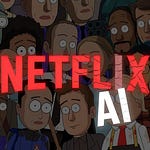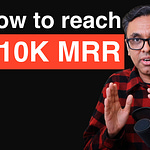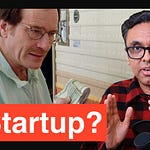Hey,
The same economics that made Spotify possible are now making AI music inevitable.
It’s a system built for scale: cheap distribution, passive listening, and algorithms that reward time spent over taste.
In 2024, that machine finally worked. Spotify turned a profit for the first time since launch.
This tends to surprise people. How can a platform with 700 million users be allergic to making money?
The answer lies in Spotify’s licensing agreements. Roughly 70% of its revenue goes to rights holders: record labels, publishers, and distributors.
The very artists who make Spotify popular are the reason its margins stay razor thin.
So while Taylor’s 26 billion streams made her Spotify’s most-played artist last year, they also made her the most expensive.
And that’s the problem. Because Spotify’s business works better when real artists aren’t involved.
AI filler, fake artists, and stream farms aren’t bugs in the system. They’re features of a model that rewards quantity over quality, and cost-cutting over creativity.
A popular piano loop with no copyright is sometimes worth more to Spotify than a chart-topping hit.
Put simply: Spotify isn’t optimizing for better music, it’s optimizing for cheaper music.
When your business depends on paying for other people’s IP, your next innovation will likely find a way to replace it.
In Spotify’s case, replacement gets easier every day. Most people can’t tell (or don’t care) whether a song was made by a person or a machine.
If it sounds good, costs less, and keeps users listening... what incentive does Spotify really have to police AI content?
Hiten
=)
I break down the full story here
Video chapters
(00:00) Why Taylor Swift isn’t profitable (for Spotify)
(00:43) Daniel Ek’s roots in piracy
(01:41) How Spotify saved the music industry
(02:04) Spotify’s surprising economics
(03:20) Why Spotify is perfect for generic content
(04:22) Bots, stream farms, and royalty scams
(05:39) The fake artist with more streams than Abba
(07:30) Major vs. indie artist takedowns
(09:26) Why Spotify doesn’t want to police AI content
(10:07) The interesting case of Velvet Sundown
(11:14) Why you should expect more AI music
Transcript
Taylor Swift was Spotify’s most-streamed artist last year with 26 billion plays.
That’s roughly 100 billion minutes of listening.
But across Spotify, users listened to 2.5 trillion minutes in total.
Taylor was just 4%.
So where’s the other 96% coming from?
That question stuck with me, and it got personal.
A while back I was in a café, heard a song I liked, and tried to Shazam it.
But nothing came up.
It got me thinking: Who made it?
That moment sent me down a rabbit hole:
Reddit threads, old news reports, stories about fake artists, and Bulgarian stream farms.
But the most interesting thing I uncovered is how Spotify might be complicit.
Because ideally, they don’t want to pay artists at all.
Before we go any further, first we need to break down how the music industry ended up here.
As you know, Spotify provides a giant online library of music that anyone can access for a monthly fee.
It ended the days of buying CDs or single songs on iTunes.
But what most people don’t know is the steps it took to get there.
This is Daniel Ek, the founder of Spotify.
He was born in Sweden, arguably the home of internet piracy.
Daniel even said this on a Freakonomics interview:
“I don’t think I would have been that interested in music if it weren’t for piracy, to be honest... We couldn’t afford all the records that I wanted.”
Before starting Spotify, he built his reputation as a teen web designer, eventually selling an online advertising company for $1 million.
He even had a stint as the CEO of uTorrent – one of the world’s most popular downloading tools, often associated with pirated content.
Then in 2008, he took on an even bigger challenge: creating a cheaper alternative to music piracy.
His idea... Spotify.
The narrative was heroic: democratize music, and hand power back to artists.
His timing couldn’t have been better.
The music industry was at rock bottom in 2008.
Their revenues had halved since the nineties.
They were desperate.
And they reluctantly agreed to license music to Spotify, a deal that would reshape the entire industry.
Fast forward to today and Spotify is a household brand name.
But the interesting thing is they have a problem.
It’s their surprising economics.
Despite 700 million users and $16 billion in annual revenue, Spotify survives on razor thin margins.
In fact, 2024 was the company’s first full profitable year since launching.
Why? Because Spotify only keeps about 30% of the money it makes.
The other 70% goes to music rights owners: Record labels, publishers, and distributors.
Every Taylor Swift or Drake stream costs Spotify more than it makes back.
At scale, those hit songs squeeze their margins.
It adds up when you’re paying out stream after stream, billions of times.
Spotify reports paying roughly $60 billion to the music industry since launching.
This model made sense when Spotify was prioritizing growth over profit.
But those days are over.
Investors are now pushing Spotify to make more money.
Raising prices more than they already have isn’t the answer.
Spotify is scared of user backlash.
The obvious way forward then is cutting licensing costs.
Analysts from Goldman Sachs have already modeled Spotify’s business.
They concluded margins would widen if more listening shifts away from major label music toward in-house, cheaper content.
In other words, Spotify doesn’t make more when you listen to better music, it makes more when you listen to cheaper music.
So if margins are the problem, here’s why AI is the answer, and why Spotify’s system is built for it.
It comes down to three key conditions.
First: the economics.
It’s a pay-per-stream model, but not all streams cost the same.
Remember, major label tracks command full royalty rates.
Meanwhile, music from smaller indie artists can be licensed for a fraction of the cost, sometimes even a one-time fee.
Every stream shifted away from Taylor Swift and toward low cost filler is better for Spotify’s bottom line.
Second: user behavior.
Most people don’t listen to music the way they used to.
You don’t sit down with an album studying the lyrics.
You put on music while you’re cooking, driving, or working.
Most listening today is passive, meaning music has become background noise.
That makes Spotify ripe for generic content.
And third: the algorithm.
Spotify doesn’t care if music is made by a human.
They care if you keep listening.
If a chill piano beat keeps you on the app, it gets pushed to your feed or placed on an official playlist, no matter who made it.
Put those three together and you get a system that rewards quantity over quality.
And it didn’t take long for outsiders to figure out how to exploit it.
Take the case of a Bulgarian man who created a massive stream farm.
He uploaded hundreds of short 30 second tracks, then used bots to play his music nonstop.
His playlists, Soulful Music and Music From The Heart, even broke into Spotify’s top 50 by revenue, despite only a couple thousand followers.
By the time he was caught, he had made over a million dollars.
What’s wild though is it was all completely legal.
He just gamed Spotify’s system.
But this had nothing on Michael Smith’s operation.
This guy combined AI generated music and stream farming.
He used AI tools to create over 500,000 tracks.
Then set up bot farms to stream them billions of times.
He made $10 million in royalties.
His scheme was so sophisticated, it flew under the radar for years.
But in 2024, he was indicted for wire fraud, conspiracy and money laundering.
The DOJ is still working the case.
And we don’t know whether what he did in regard to gaming Spotify’s system is actually illegal.
These two cases prove something important.
Spotify’s system, and its three key conditions, doesn’t just allow gaming, it rewards it.
Here’s the irony.
Every fake stream saves Spotify money compared to a real one.
And if outsiders can pull this off, imagine the incentive for insiders.
Here’s where the story takes a darker turn.
At first, it sounded like a conspiracy theory.
On Reddit and music forums, users noticed strange patterns.
Artists with no social media presence, no fan base, no touring history.
Yet somehow they showed up again and again on Spotify’s curated playlists.
Speculation turned into evidence when a Swedish newspaper launched an investigation into Yohan Raw.
Don’t worry if you haven’t heard of him, because you’ve probably heard his music.
He released nearly 3000 tracks under 650 fake names and racked up 15 billion streams.
That’s more than Ah-bah or Elton John.
You may have seen his music on official playlists, like Stress Relief and Peaceful Piano.
Just not under his actual name.
And Raw wasn’t the only one.
The newspaper traced more than 800 fake artists back to Firefly Entertainment.
A Swedish label with close ties to a former Spotify exec.
The reporting showed that roughly 20 real people were behind at least 500 of those aliases.
There were also questions about whether the label benefited from Spotify recommendations or playlist placements…
Firefly’s revenues grew tenfold between 2017 and 2020.
The controversy didn’t stop there.
Multiple investigations suggested Spotify struck reduced royalty deals with a number of labels and artists.
Here’s how it worked.
Instead of the standard payout, the 70/30 split, some artists accepted a quarter of the usual rate.
This was in exchange for spinning up fake artist accounts, and pumping out cookie cutter background music.
They were also promised spots on playlists, like Deep Focus or Ambient Chill.
These arrangements allowed Spotify to fill its music library with low-effort filler every week to keep users streaming.
While there’s no concrete proof, the incentives make a compelling case.
It’s not the in-house content those analysts from Goldman Sachs once imagined.
But every time these tracks replace a real artist, on an official playlist, Spotify makes more money, while musicians lose income.
Now, you might be thinking, surely Spotify has rules against this, right?
Well, not necessarily.
Spotify’s official line is clear.
They don’t ban AI generated content.
All tracks are treated equally.
And in terms of fake artists, their response is that “stage names” have been common practice in the industry for decades.
What they do ban is deceptive content.
But what counts as deceptive?
That seems to depend on who’s being deceived.
Take the 2023 viral song Heart On My Sleeve, which was apparently a new track by Drake and The Weekend.
It exploded across social media.
15 million views on TikTok and over 600,000 streams on Spotify in just one week.
It was even submitted for a Grammy nomination for best rap song.
But it was eventually disqualified for lacking “human authorship.”
Because it turned out the song was created by someone called Ghostwriter677.
They used AI tools to clone the voices, and probably make the beat too.
But when Drake’s team got involved, the song was yanked from every platform within days.
Now compare that to Emily Portman, a British folk singer.
In August, 2025, she woke up to fans congratulating her on a great new album.
The problem was she hadn’t released one.
Someone had uploaded an AI generated record called Orca to her official Spotify page.
It was complete with convincing writing credits and song titles.
Even Emily herself admitted the AI had done a scary job imitating her delivery and songwriting style.
She even said: “I’ll never be able to sing that perfectly in tune”.
But despite reporting the issue immediately, it took Spotify three weeks to remove the album.
This was long enough to rack up thousands of streams and mislead her actual fans.
And within days of taking it down, another fake album appeared in its place.
The message was clear.
If you’re Drake, the takedown is swift.
If you’re an indie artist, you’re on your own.
This imbalance has the whole industry on edge.
Universal Music Group and others are lobbying hard for AI takedowns.
They back legislation like Tennessee’s Elvis Act, which makes unauthorized voice cloning illegal.
And more than 200 artists, including Billie eye-lish, Stevie Wonder, Nicki Minaj, and Katie Perry signed an open letter demanding more protection.
The letter stated: “The use of AI to replace human artistry with machine generated content dilutes the royalty pool that is meant to reward human creativity”.
But here’s the fundamental tension.
Spotify’s business model makes policing AI content nearly impossible.
Every extra dollar spent on detection, every human hour spent reviewing flagged content, every real artist stream they protect.
It all works against Spotify’s bottom line.
Essentially, labels are asking Spotify to act against its own business model.
And history suggests which way Spotify will lean.
But while the industry fights back, the technology isn’t waiting.
It’s actually getting better.
There’s been an explosion of AI music startups like Soo-no and MusicLM.
Think of these like the pickaxes in the Gold Rush.
People are using them to flood music platforms with AI generated tracks.
We don’t know the exact number for Spotify.
But a French streaming service called Dee-zer recently said 20,000 AI tracks are uploaded to its platform every single day.
None have been more impressive though than a band called Velvet Sundown.
In June, 2025, they released an album to critical acclaim and genuine fan enthusiasm.
It got over a million streams within weeks.
Two more albums dropped in just a few months.
Music bloggers praised the vintage vibe, calling it an authentic 70s rock revival.
But then came the reveal.
The entire album was AI generated using Suno.
Every vocal, every guitar riff, every drum fill.
Suddenly the same songs were dismissed as soulless AI.
The interesting thing here is that most people can’t tell the difference.
And people like it until they know it’s machine generated.
So this raises a burning question.
If it sounds good, people like it, and it’s cheaper to distribute…
What incentive does Spotify really have to remove AI content?
This brings us full circle to Spotify’s founder, the man who swooped in to solve music piracy with Spotify.
Artists once praised him.
Now they say he’s created something worse.
If AI music becomes infinite, the long tail of smaller independent artists may simply vanish.
Spotify isn’t asking whether AI music is coming.
They’re asking how much of it can they afford to put in front of you.
Because the economics point in only one direction.
The tech keeps getting better.
Spotify wants to make their platform as sticky as possible.
And users want recommendations that match their mood.
I hope it’s clear by now that Daniel never set out to destroy human creativity.
But he might have built the perfect machine to do exactly that.
And this time there might not be a heroic narrative for Spotify to hide behind.
Because Taylor Swift may be their biggest star, but the real winner might be AI.
So the next time you hear a track you can’t Shazam, don’t be surprised like I was.
It might not be a person at all.









